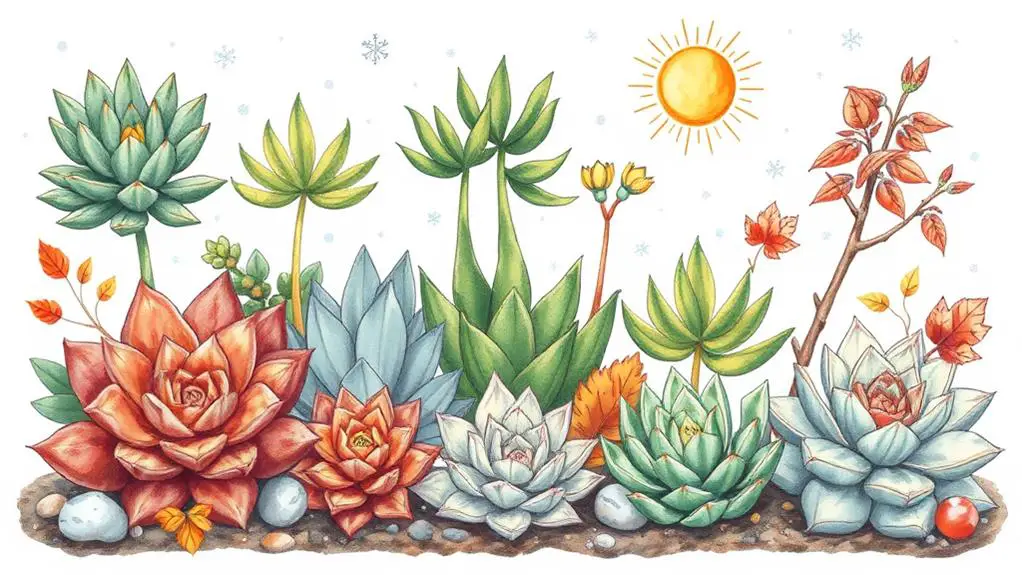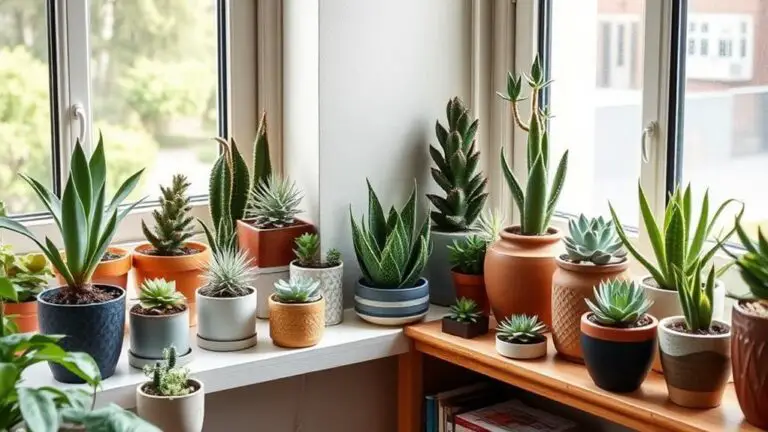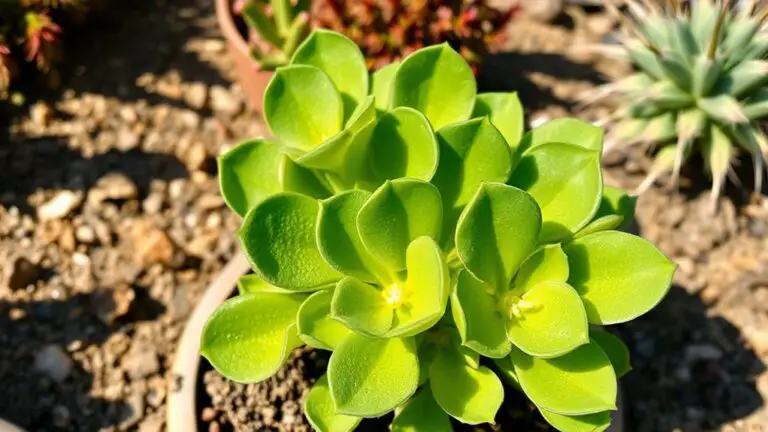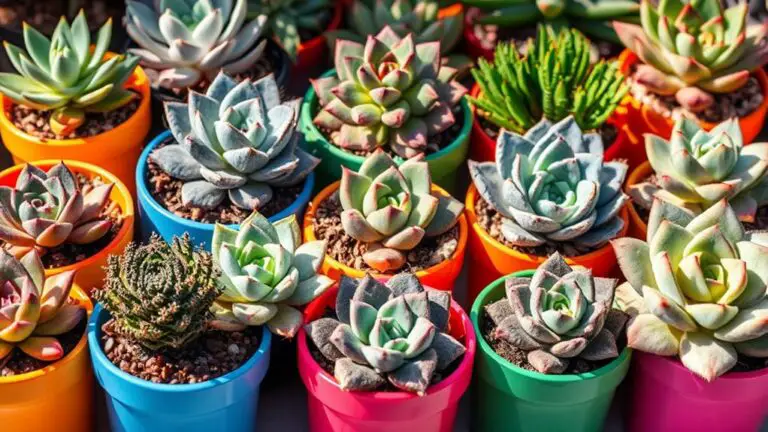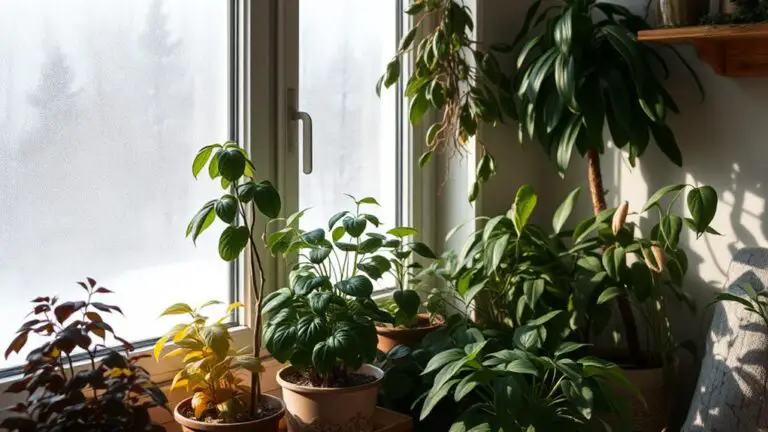Succulent Dormancy Table – A Detailed How-To Guide
If you've ever wondered why your succulents seem to stop growing or change color at certain times of the year, you're not alone. Understanding dormancy in succulents is essential for their care, as it involves recognizing when they're in a resting phase and adjusting your maintenance routine accordingly. Differentiating between summer and winter growers can profoundly affect how you water, fertilize, and position your plants. Let's explore how identifying these dormancy signs can lead to healthier succulents and guarantee they thrive year-round. Curious about the specifics of summer and winter growers?
Understanding Dormancy in Succulents

Understanding dormancy in succulents is vital for ensuring their health and longevity. Dormancy is a temporary phase where your succulent reduces its metabolic activity due to extreme conditions like high heat or cold. Knowing when and why this happens helps you provide better care.
There are two main types of succulents: summer growers and winter growers. Summer growers, such as Echeveria, go dormant in winter, while winter growers, like Aeonium, slow down in summer. This means their care instructions differ considerably depending on the season.
For instance, summer growers need minimal watering during their winter dormancy, while winter growers require limited water in the summer.
During dormancy, your succulent conserves energy, and it's important to adjust your care routine accordingly. Overwatering is a common mistake; remember, their metabolic activity is low, so they don't need much water.
Learn the dormancy patterns specific to each species to avoid this.
Signs of Dormancy
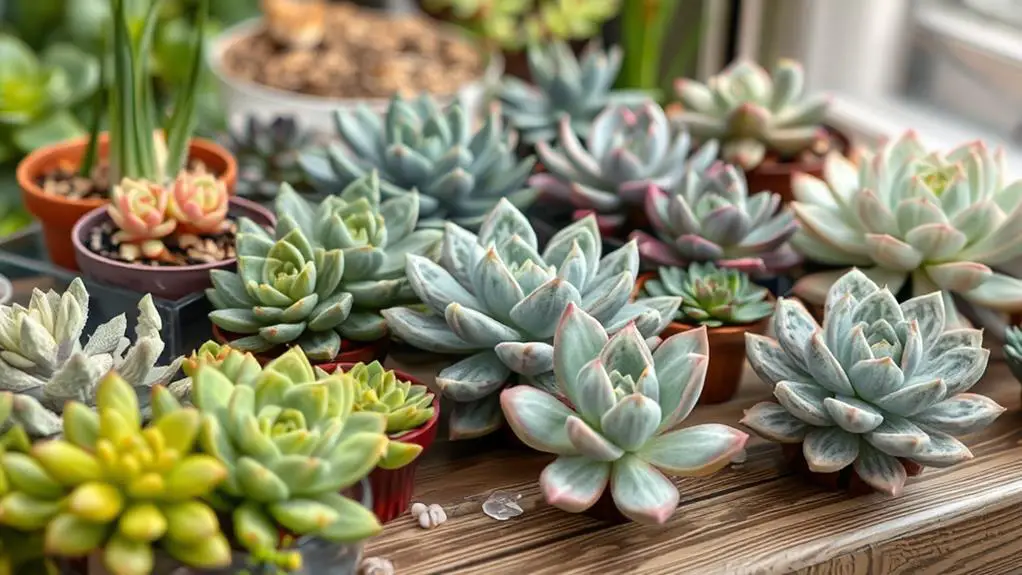
Recognizing the signs of dormancy in your succulents can help you adjust their care to keep them healthy. When your succulent enters its dormant period, you'll notice a lack of new growth. This means the plant is conserving energy and isn't actively growing.
Another common sign is color changes in the leaves. They might turn yellow or brown, and some may even drop off or hang limply.
If you have rosette succulents, their rosettes might contract and look smaller and tighter. This is normal during dormancy and indicates the plant is in a resting phase.
To check if your succulent is healthy, try the Snap-Scratch test. Healthy succulents will snap cleanly when you gently bend a leaf, while unhealthy ones may bend or tear.
Examining the roots can give you more clues. During dormancy, healthy roots will still be firm and intact. If the roots appear rotted, your plant might be in trouble.
Understanding these signs of dormancy guarantees your succulents get the right care, helping them thrive even during their resting period. Stay observant, and your plants will thank you by staying strong and healthy!
Summer vs. Winter Growers

Understanding the differences between summer and winter growers is key to keeping your succulents healthy.
Summer growers, like Echeveria, slow down when temperatures soar above 90°F, needing less water, while winter growers, such as Sempervivum, go dormant in cooler weather around 40°F.
Knowing when each type enters dormancy helps you adjust your watering schedule and temperature settings for ideal growth.
Dormant Season Differences
Steering through the differences in dormant seasons between summer and winter growers is key to successful succulent care.
Understanding when your succulents go dormant helps you tailor your care routine effectively. Summer growers, like Echeveria and Sedum, enter their dormancy period during the hot summer months. During this time, they need minimal water and protection from excessive heat.
They start actively growing again in the cooler fall and winter temperatures.
On the other hand, winter dormant succulents, such as Agave and Sempervivum, conserve their energy in the colder months.
These plants typically thrive during the warmer summer season. It's important to provide them with adequate water to support their growth during this time.
Watering During Dormancy
When managing the watering of succulents during their dormancy periods, it's vital to tailor your approach based on whether they're summer or winter growers.
Summer-growing succulents require minimal watering during their winter dormancy. You should only water them when their leaves show signs of wrinkling due to dehydration. Before you water, always check the soil moisture. Make sure the top inch of soil is completely dry to prevent root rot.
On the other hand, winter-growing succulents need regular watering during their summer dormancy. This helps keep their roots cool and prevents stress, especially when temperatures rise. You might need to water winter growers every few weeks during dormancy, but always check soil moisture first.
Indoor succulents mightn't experience true dormancy. For these, consistent watering is key. Let the soil dry out between waterings to avoid root rot.
Understanding each succulent's specific watering needs based on its growth cycle is important. Overwatering during dormancy can lead to root rot and plant decline.
Temperature Impact Analysis
Watering practices during dormancy should be aligned with the temperature impacts on succulent growth cycles. For summer-growing succulents like Echeveria and Crassula, dormancy kicks in when the temperature exceeds 90°F. At this point, they need reduced watering to prevent stress and dehydration.
On the flip side, winter growers, such as Sempervivum and Adenium, slow down their growth as winter temperatures drop below 40°F, requiring only minimal watering.
Understanding these temperature effects is essential for keeping your succulents healthy. Many succulents thrive during spring and fall when night temperatures range between 50°F and 60°F, offering ideal growing conditions.
During extreme heat, succulents enter a survival mode, becoming dormant to conserve water. Conversely, freezing temperatures halt their growth and can cause damage.
To manage this, always check the specific temperature ranges suitable for each succulent species. By doing this, you'll know when to adjust watering schedules and other care practices.
This helps guarantee your succulents remain vibrant and healthy throughout their growing and dormant periods. With careful attention, you'll support your succulents through each season, making your gardening journey smoother and more rewarding.
Caring for Dormant Succulents
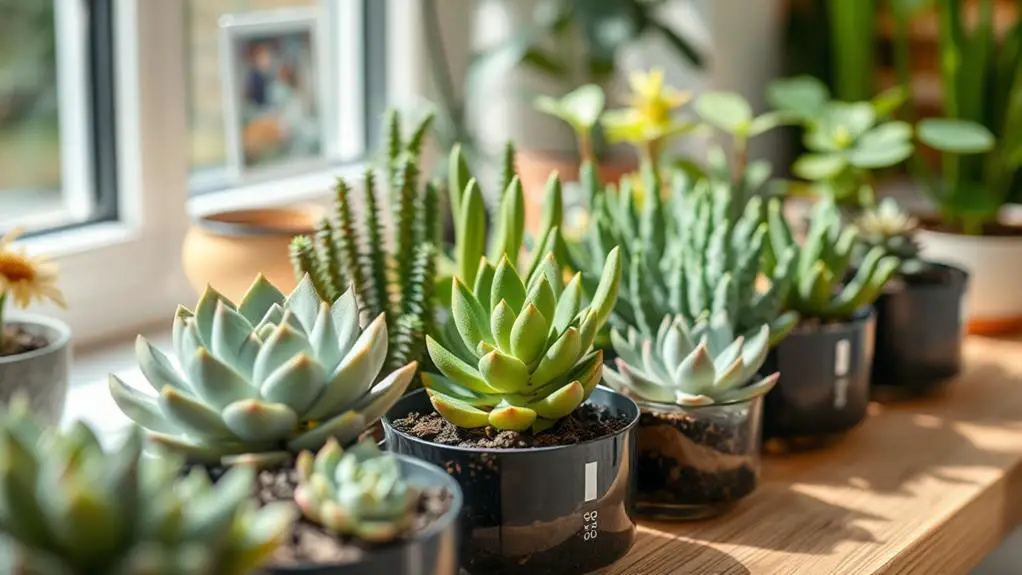
Caring for dormant succulents requires a careful balance to guarantee they remain healthy during their rest period.
First, greatly reduce watering frequency. Let the soil dry out completely between waterings to prevent root rot. If you notice leaves looking wrinkled or shriveled, it might mean your plant needs a small amount of water, but be cautious—too much moisture can be harmful.
Next, avoid fertilizing your dormant succulents. They need minimal nutrients while dormant, and over-fertilizing can damage them. Just let them rest without adding any extra nutrients.
Light is another important factor. Place your succulents in a spot with adequate indirect light. They still need some light for photosynthesis, but direct sunlight can cause stress. Make sure they get a gentle amount of light each day.
Lastly, keep the temperature stable. Aim for a range between 50-65°F. This helps support the dormancy process and keeps your succulents from unnecessary stress.
Preparing for Seasonal Changes
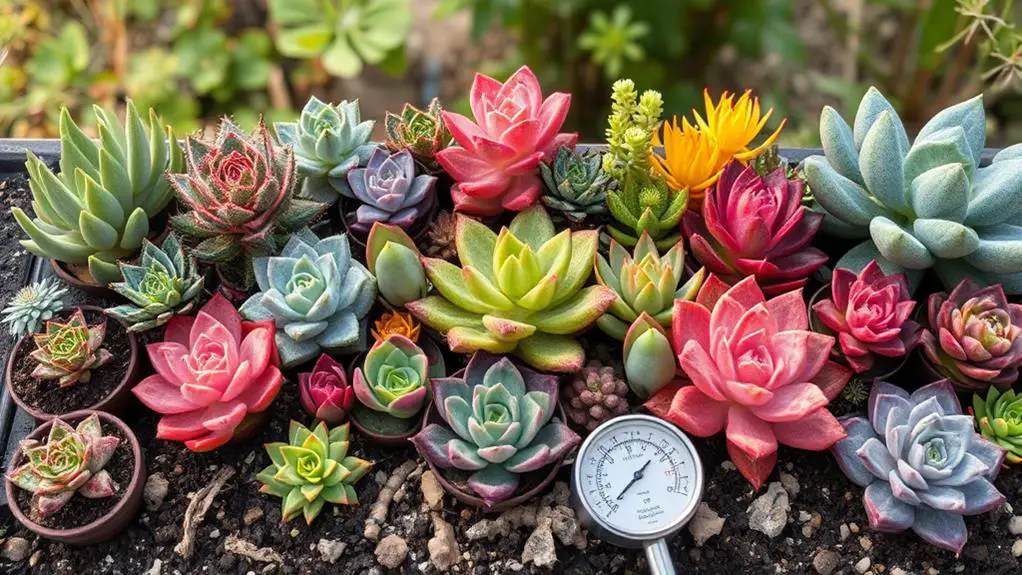
As the seasons change, adjusting your watering routines and managing temperatures are key to keeping your succulents healthy.
Reduce watering for dormant succulents to prevent root rot, and make certain to protect them from extreme cold by using mulch or covers.
Adjusting Watering Routines
When preparing for seasonal changes, it's important to adjust your watering routines to meet the specific needs of your succulents. During their summer dormant phase, succulents need much less water. You should only water them when their leaves show signs of wrinkling.
In contrast, succulents that are winter dormant require more frequent watering during the summer to keep their roots cool.
To handle these changes effectively, use a succulent dormancy table. This tool helps you identify whether your succulents are summer or winter growers, allowing you to adjust your watering routines accordingly. For instance, during their period of active growth, you'll need to monitor their water needs more closely.
Indoor succulents may not go through true dormancy. Instead, keep a consistent watering schedule to guarantee they stay healthy year-round.
For outdoor succulents like Sempervivum, watering during winter dormancy isn't necessary when temperatures drop below freezing—they can survive without moisture.
Temperature Management Tips
Managing temperature is essential for keeping your succulents healthy through seasonal changes. Proper temperature management helps guarantee your plants don't get stressed and remain in great shape.
For indoor succulents, aim to keep temperatures between 50-65°F during dormancy. This range prevents stress and promotes a healthy recovery phase.
If you have outdoor succulents, protect winter growers from freezing temperatures. Use mulch or coverings to insulate them during harsh weather. It's important to adjust your watering habits as well. Reduce watering during cold spells since soil retains moisture longer and roots can rot if they stay too wet.
During extreme heat, anything over 90°F, provide shade for summer dormant succulents. This reduces stress and prevents them from entering a prolonged dormancy.
Sudden temperature changes can also trigger dormancy, so acclimate your plants gradually. This helps avoid shock and maintains ideal growth conditions.
Temperature Tolerance
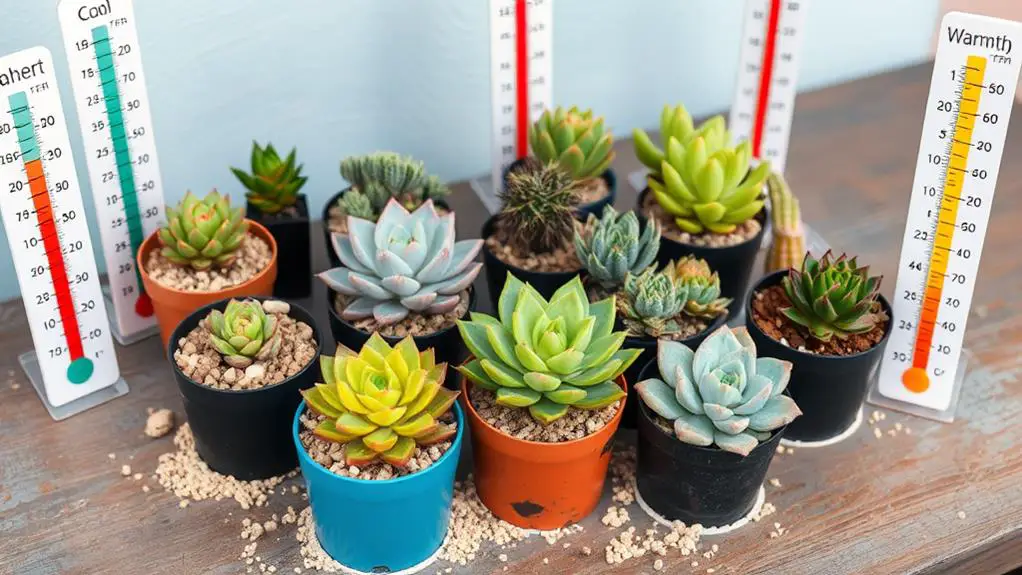
Temperature tolerance is a key factor in succulent care, as different species have varying needs. Some succulents, like Sempervivum, can handle freezing temperatures and even frost, going into a survival mode when it's cold. Others, like Echeveria, thrive in moderate heat but struggle when temperatures drop too low. Knowing the temperature tolerance of your succulents helps you keep them healthy and avoid unnecessary dormancy.
During spring and fall, most succulents are actively growing and prefer temperate conditions. When temperatures get extreme, either too hot or too cold, succulents might enter dormancy to protect themselves.
For instance, cacti and Agave love warmer climates but stop growing when it gets too hot, over 100°F. Curiously, many cacti need a cold period around 40°F for at least 60 days to bloom.
High temperatures above 90°F can stress your succulents, causing them to tighten and shrink. This stress often leads to temporary dormancy. Understanding the specific temperature preferences and tolerances of each succulent species is essential.
This knowledge guarantees that you can provide the best care, helping your plants thrive without slipping into survival mode unnecessarily.
Watering Needs During Dormancy
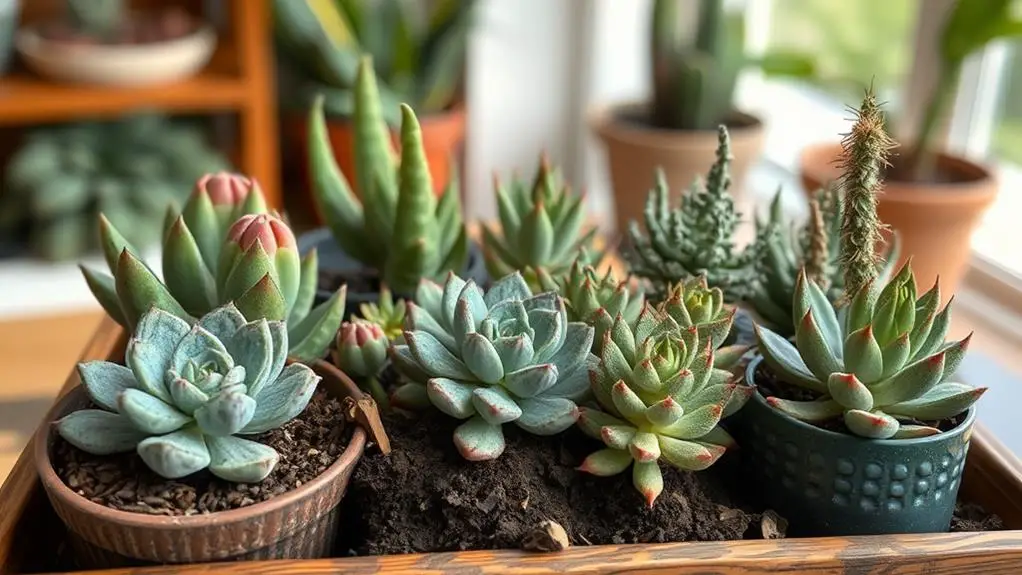
Understanding the temperature tolerance of your succulents is just one part of their care; equally important is knowing their watering needs during dormancy.
During this period, succulents require markedly less water. Only provide moisture when you notice the leaves wrinkling or shriveling. This helps prevent overwatering, which can lead to root rot and other issues.
For summer dormant succulents, you should water them minimally during the winter months. On the other hand, winter dormant varieties might need occasional watering during summer to keep their roots cool.
It's crucial to monitor the leaves and soil moisture levels regularly to determine the right time for watering. Here's a quick guide:
- Monitor leaf condition: Watch for signs of wrinkling or shriveling.
- Check soil moisture: Confirm the soil is completely dry before watering.
- Avoid overwatering: Too much water can damage the roots.
Useful Resources and Tips
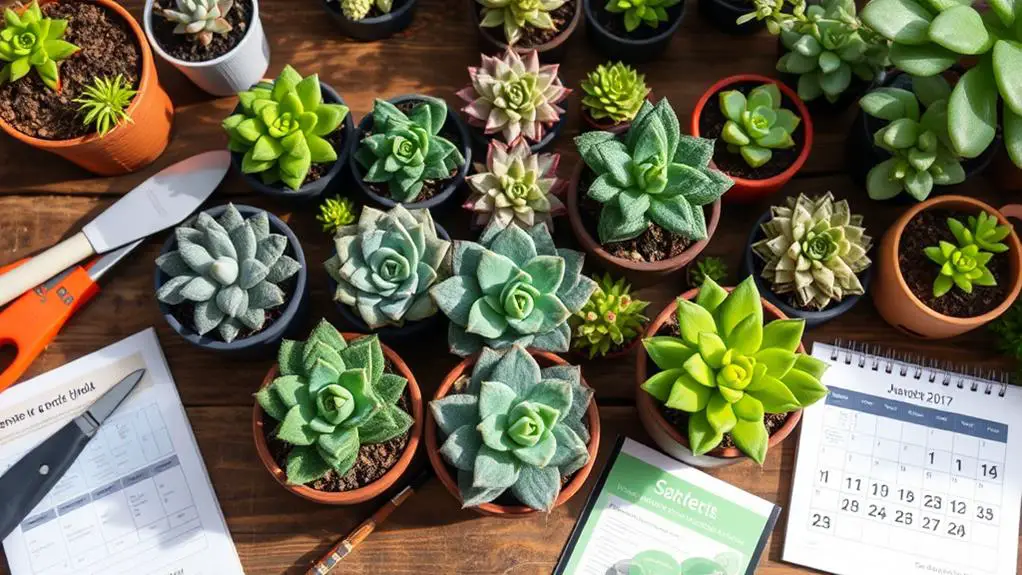
Succulent care can be made easier with the right tools and knowledge at your disposal. When succulents go dormant, it's crucial to adapt your care routine to their needs. Utilizing succulent dormancy tables will help you identify specific dormancy patterns for various species, allowing you to tailor your care techniques effectively.
Engage with succulent care communities on platforms like Facebook and Instagram. These groups share experiences and expert advice that can be invaluable in managing dormant plants. Additionally, subscribing to newsletters or online courses that focus on seasonal care strategies will equip you with innovative tips.
A care journal is another excellent resource. Track your watering schedules, environmental conditions, and growth signs. This will refine your understanding of each succulent's needs during dormancy. Using watering cheat sheets and care guides guarantees your plants stay healthy and recover well post-dormancy.
Here's a quick table summarizing these useful resources and tips:
| Resource | Description |
|---|---|
| Dormancy Tables | Identify specific dormancy patterns |
| Online Communities | Share experiences and get expert advice |
| Newsletters/Courses | Learn seasonal care strategies and innovative tips |
| Care Journal | Track watering, conditions, and growth signs |
| Cheat Sheets | Guarantee ideal health and recovery post-dormancy |
Frequently Asked Questions
How to Care for Dormant Succulents?
You should water dormant succulents sparingly, only when leaves wrinkle. Keep temperatures between 50-65°F and avoid fertilizing. Provide indirect light, monitor for pests, and guarantee cooler conditions to help them conserve energy.
What Temperature Do Succulents Go Dormant At?
Succulents typically go dormant when temperatures fall below 40°F or exceed 90°F. Winter dormant varieties become inactive under 50°F, while summer dormant types slow down in extreme heat, especially over 90°F. Know your species' tolerance.
When to Repot Summer Dormant Succulents?
Repot summer dormant succulents in early spring, just before their growing season starts. Make certain the soil is dry to avoid root damage. Check for root crowding and use well-draining soil. Don't water immediately after repotting.
What Season Do Succulents Go Dormant?
Succulents' dormancy depends on their type. Summer dormant succulents rest in hot months and grow in cooler seasons. Winter dormant succulents slow down in colder months and thrive in warmer conditions. Know your plant's specific needs.
Conclusion
You've got this! Understanding succulent dormancy might seem tricky at first, but with this guide, you're well-equipped. Remember to look for signs like lack of growth and color changes, and adjust your care routine accordingly. Whether you're dealing with summer or winter growers, just be mindful of their needs. Keep an eye on temperature and water sparingly during dormancy. With these tips, your succulents will thrive year-round. Happy gardening!

